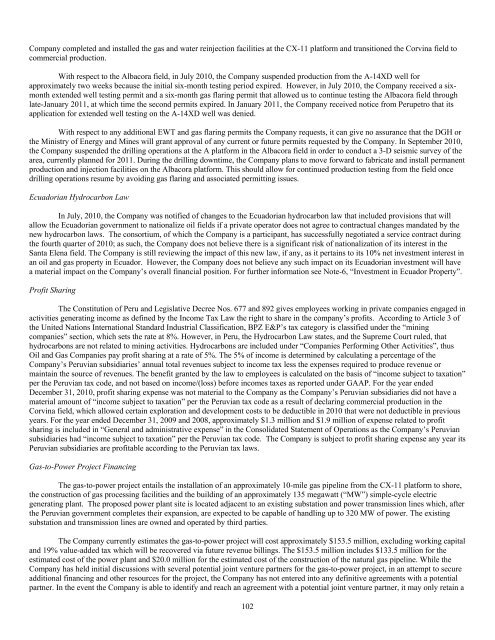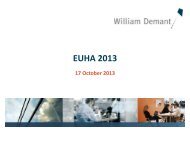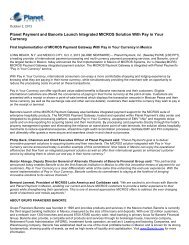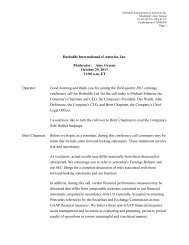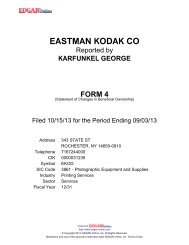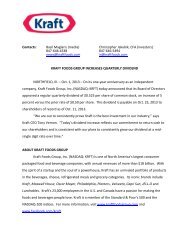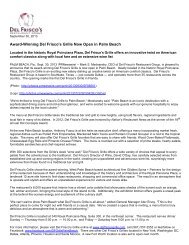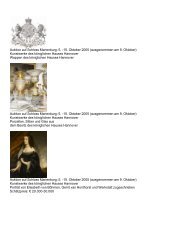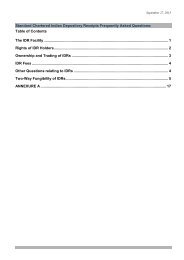BPZ Resources, Inc. - Shareholder.com
BPZ Resources, Inc. - Shareholder.com
BPZ Resources, Inc. - Shareholder.com
Create successful ePaper yourself
Turn your PDF publications into a flip-book with our unique Google optimized e-Paper software.
Company <strong>com</strong>pleted and installed the gas and water reinjection facilities at the CX-11 platform and transitioned the Corvina field to<br />
<strong>com</strong>mercial production.<br />
With respect to the Albacora field, in July 2010, the Company suspended production from the A-14XD well for<br />
approximately two weeks because the initial six-month testing period expired. However, in July 2010, the Company received a sixmonth<br />
extended well testing permit and a six-month gas flaring permit that allowed us to continue testing the Albacora field through<br />
late-January 2011, at which time the second permits expired. In January 2011, the Company received notice from Perupetro that its<br />
application for extended well testing on the A-14XD well was denied.<br />
With respect to any additional EWT and gas flaring permits the Company requests, it can give no assurance that the DGH or<br />
the Ministry of Energy and Mines will grant approval of any current or future permits requested by the Company. In September 2010,<br />
the Company suspended the drilling operations at the A platform in the Albacora field in order to conduct a 3-D seismic survey of the<br />
area, currently planned for 2011. During the drilling downtime, the Company plans to move forward to fabricate and install permanent<br />
production and injection facilities on the Albacora platform. This should allow for continued production testing from the field once<br />
drilling operations resume by avoiding gas flaring and associated permitting issues.<br />
Ecuadorian Hydrocarbon Law<br />
In July, 2010, the Company was notified of changes to the Ecuadorian hydrocarbon law that included provisions that will<br />
allow the Ecuadorian government to nationalize oil fields if a private operator does not agree to contractual changes mandated by the<br />
new hydrocarbon laws. The consortium, of which the Company is a participant, has successfully negotiated a service contract during<br />
the fourth quarter of 2010; as such, the Company does not believe there is a significant risk of nationalization of its interest in the<br />
Santa Elena field. The Company is still reviewing the impact of this new law, if any, as it pertains to its 10% net investment interest in<br />
an oil and gas property in Ecuador. However, the Company does not believe any such impact on its Ecuadorian investment will have<br />
a material impact on the Company’s overall financial position. For further information see Note-6, “Investment in Ecuador Property”.<br />
Profit Sharing<br />
The Constitution of Peru and Legislative Decree Nos. 677 and 892 gives employees working in private <strong>com</strong>panies engaged in<br />
activities generating in<strong>com</strong>e as defined by the <strong>Inc</strong>ome Tax Law the right to share in the <strong>com</strong>pany’s profits. According to Article 3 of<br />
the United Nations International Standard Industrial Classification, <strong>BPZ</strong> E&P’s tax category is classified under the “mining<br />
<strong>com</strong>panies” section, which sets the rate at 8%. However, in Peru, the Hydrocarbon Law states, and the Supreme Court ruled, that<br />
hydrocarbons are not related to mining activities. Hydrocarbons are included under “Companies Performing Other Activities”, thus<br />
Oil and Gas Companies pay profit sharing at a rate of 5%. The 5% of in<strong>com</strong>e is determined by calculating a percentage of the<br />
Company’s Peruvian subsidiaries’ annual total revenues subject to in<strong>com</strong>e tax less the expenses required to produce revenue or<br />
maintain the source of revenues. The benefit granted by the law to employees is calculated on the basis of “in<strong>com</strong>e subject to taxation”<br />
per the Peruvian tax code, and not based on in<strong>com</strong>e/(loss) before in<strong>com</strong>es taxes as reported under GAAP. For the year ended<br />
December 31, 2010, profit sharing expense was not material to the Company as the Company’s Peruvian subsidiaries did not have a<br />
material amount of “in<strong>com</strong>e subject to taxation” per the Peruvian tax code as a result of declaring <strong>com</strong>mercial production in the<br />
Corvina field, which allowed certain exploration and development costs to be deductible in 2010 that were not deductible in previous<br />
years. For the year ended December 31, 2009 and 2008, approximately $1.3 million and $1.9 million of expense related to profit<br />
sharing is included in “General and administrative expense” in the Consolidated Statement of Operations as the Company’s Peruvian<br />
subsidiaries had “in<strong>com</strong>e subject to taxation” per the Peruvian tax code. The Company is subject to profit sharing expense any year its<br />
Peruvian subsidiaries are profitable according to the Peruvian tax laws.<br />
Gas-to-Power Project Financing<br />
The gas-to-power project entails the installation of an approximately 10-mile gas pipeline from the CX-11 platform to shore,<br />
the construction of gas processing facilities and the building of an approximately 135 megawatt (“MW”) simple-cycle electric<br />
generating plant. The proposed power plant site is located adjacent to an existing substation and power transmission lines which, after<br />
the Peruvian government <strong>com</strong>pletes their expansion, are expected to be capable of handling up to 320 MW of power. The existing<br />
substation and transmission lines are owned and operated by third parties.<br />
The Company currently estimates the gas-to-power project will cost approximately $153.5 million, excluding working capital<br />
and 19% value-added tax which will be recovered via future revenue billings. The $153.5 million includes $133.5 million for the<br />
estimated cost of the power plant and $20.0 million for the estimated cost of the construction of the natural gas pipeline. While the<br />
Company has held initial discussions with several potential joint venture partners for the gas-to-power project, in an attempt to secure<br />
additional financing and other resources for the project, the Company has not entered into any definitive agreements with a potential<br />
partner. In the event the Company is able to identify and reach an agreement with a potential joint venture partner, it may only retain a<br />
102


